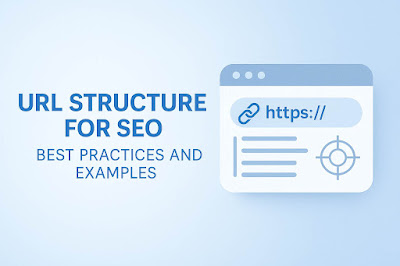URL Structure for SEO in 2025: Best Practices, Examples, and Mistakes to Avoid
URL Structure for SEO in 2025: Best Practices, Examples, and Mistakes to Avoid

If you want to boost your search rankings and offer a smoother experience to your readers, optimizing your URL structure is no longer optional—it’s essential.
URLs are more than just web addresses; they tell search engines and users what your page is about before they even land on it.
In this guide, we’ll break down:
Let’s get into it.
In this guide, we’ll break down:
- What makes a good URL structure
- How to create SEO-friendly URLs
- Common URL structure mistakes (and how to fix them)
- Real examples and best practices for 2025
Let’s get into it.
Why URL Structure Matters for SEO
A clean and organized URL helps both users and search engines understand your content faster.Here’s why it matters:
Google has confirmed that URL structure is a ranking factor—so optimizing it helps your visibility and performance.
- Improves indexing: Search engines crawl and index structured URLs more easily.
- Boosts click-through rates: Clear URLs are more trustworthy and clickable.
- Enhances user experience: Descriptive URLs help users know what to expect.
Google has confirmed that URL structure is a ranking factor—so optimizing it helps your visibility and performance.
The Basic Anatomy of a URL
Before we dive into best practices, let’s look at what makes up a typical URL:Example:
https://www.example.com/blog/seo-tips?source=pinterest#section2
Protocol:
https – ensures secure data transfer (use HTTPS for SEO and trust).
Domain name:
www.example.com – your unique web address.
Path: /blog/seo-tips – shows the page location.
Path: /blog/seo-tips – shows the page location.
Parameters:
?source=pinterest – optional data used for tracking.
Anchor: #section2 – links to a specific part of the page.
Anchor: #section2 – links to a specific part of the page.
Best Practices for a Strong URL Structure
Here are actionable tips to build SEO-friendly URLs in 2025:1. Keep URLs Short and Simple
Long URLs confuse both users and search engines.Try to:
Stay under 100 characters
Remove unnecessary words like “a,” “the,” “and,” etc.
Bad: https://example.com/blog/2025/how-to-create-the-best-seo-friendly-url-structure-ever
Stay under 100 characters
Remove unnecessary words like “a,” “the,” “and,” etc.
Bad: https://example.com/blog/2025/how-to-create-the-best-seo-friendly-url-structure-ever
Good: https://example.com/seo/url-structure
2. Use Keywords Naturally
Include one or two relevant keywords in the URL to match search intent.Avoid keyword stuffing—it does more harm than good.
Example:
/affiliate-marketing-tips is better than /page123?id=4
3. Use Hyphens Instead of Underscores
Google recommends hyphens (-) because they’re easier to read and index.Use: your-blog.com/seo-tips
Avoid: your-blog.com/seo_tips
4. Stick to Lowercase Letters
URLs are case-sensitive.Mixing uppercase and lowercase can cause duplicate content issues.
Tip: Always use lowercase to stay consistent and avoid SEO confusion.
Tip: Always use lowercase to stay consistent and avoid SEO confusion.
5. Avoid Special Characters
Characters like @, %, $, and & can break URLs or create encoding issues.Stick to:
- Letters
- Numbers
- Hyphens
6. Create a Consistent URL Structure
Use a logical, organized structure across your site.For example:
Blog posts: /blog/topic-title
Categories: /category-name/
This consistency helps both users and search engines navigate your site better.
Better: example.com/seo-checklist
Blog posts: /blog/topic-title
Categories: /category-name/
This consistency helps both users and search engines navigate your site better.
7. Use a Flat URL Hierarchy When Possible
A flat hierarchy means fewer clicks to reach any page, improving crawl efficiency.Better: example.com/seo-checklist
Worse:
example.com/blog/seo/2025/june/advanced/seo-checklist
Google gives ranking advantages to secure websites.
example.com/page?id=39483&cat=9&type=a
Instead, use clear paths:
example.com/seo/url-structure-guide
8. Always Use HTTPS
It’s no longer a bonus—it’s a requirement.Google gives ranking advantages to secure websites.
Common URL Structure Mistakes to Avoid
Even small URL issues can negatively affect SEO. Watch out for these:1. Dynamic URLs with Random Parameters
Avoid messy URLs like:example.com/page?id=39483&cat=9&type=a
Instead, use clear paths:
example.com/seo/url-structure-guide
2. Keyword Stuffing
Stuffing URLs with multiple keywords looks spammy and reduces readability.Stick to 1–2 keywords max per URL.
3. Changing URLs Without Redirects
If you update a URL, use 301 redirects to point the old version to the new one.Otherwise, you lose SEO value and create broken links.
4. Ignoring Internal Links
When changing URLs, don’t forget to update all internal links.Broken links = poor user experience + bad SEO.
How to Safely Change Your URL Structure
If you need to improve your existing URL structure, follow these steps:1. Backup your site
2. Set up 301 redirects from old URLs to new ones
3. Update all internal links across your site
4. Submit your updated sitemap to Google Search Console
5. Monitor traffic and rankings to catch issues early
Real-World Examples of SEO-Friendly URLs
Let’s compare two real examples:Bad URL:
www.site.com/index.php?id=143§ion=seo&lang=en
Good URL:
www.site.com/seo/url-structure-guide
Which one would you click?
Bonus Tips for 2025
Breadcrumb URLs: Use breadcrumb-style slugs like /blog/seo/url-structure to show hierarchy.Mobile-first mindset: Keep URLs readable on small screens.
Use canonical tags: Prevent duplicate content issues by setting a preferred version of the page.
Final Thoughts
Optimizing your URL structure is one of the easiest and most powerful SEO wins in 2025.It improves crawlability, rankings, and user trust—all at once.
Remember:
Keep it short, clean, and descriptive
Use keywords wisely
Avoid clutter and complexity
Whether you're launching a new blog or optimizing an existing one, your URL structure can either support or sabotage your SEO goals.
Remember:
Keep it short, clean, and descriptive
Use keywords wisely
Avoid clutter and complexity
Whether you're launching a new blog or optimizing an existing one, your URL structure can either support or sabotage your SEO goals.
So, don’t ignore it—leverage it.
Post a Comment